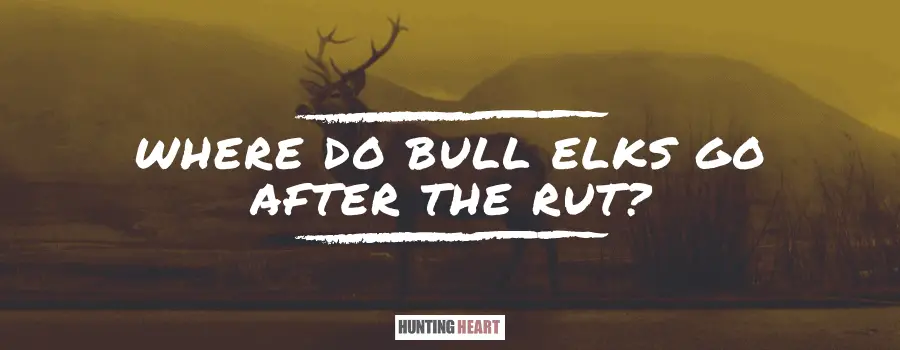As an Amazon Associate I earn from qualifying purchases.
Our Associate portal can be found here
The rut is the period where a bull elk sees the most cruelty in all seasons. The level of incurred damage wounds is not only on its antlers but also on its limbs and body. After such an experience, even you would want to hide out and get some time for yourself. So, where do bull elks go after the rut? The dark spots in the forest area are where the bull elk disappear after the intense rut season.
Not only is the stress physical but also internal distress, especially on its reproductive system. The sperm produces humongous since bulls are known to be powerful animals. After the one month, it is worn out and seeks to replenish the lost energy.
Where Do They Go?
After the rut, bull elks head towards dark, heavily infested tree-covered areas to seclude themselves from various activities. Their main goal of seclusion is to shed its antler and heal its body wounds while replenishing their lost energy from all the fights and mating sessions.
These areas, preferably dark, act as a refuge point for them to seek fortitude. It is from them that they feed, eat, and sleep in small herds. All energy-draining activities come to a halt and only apply in extreme circumstances. If you get to observe the bull after the rut, you will testify beside us that they are not as energetic as their previous selves.
However, do not be tempted to intentionally irritate it as it has enough energy to cause terror. Since hunting season is already in progress, they are wary and alert all the time. If they find you an immediate danger, then you will be in for some trouble. Your main chance of running into one is hanging around water catchment areas or observing their herds along their routes.
Why Do Elks Have to Rest After the Rut?
Physical Injury during the Rut
Among the many activities that go on between this species during the rut, fighting is the most prominent. Besides, every female elk has two bulls ready to battle with the massive antlers acting as weapons. This fight’s intensity is underrated as if the loser escapes with its life; then, it incurs massive wounds.
After the rut, they can shed their antlers and gather enough energy and nutrients to grow another strong pair before the next rut. In America, elk researchers report over 60 antler injuries in a single animal. The massive individuals have an advantage over lesser opponents, and so do they mate with many cows and incur fewer damages.
Note that not only are their antlers hurt, but also their body parts, especially limbs. Other opponents tend to aim for the body during the fight rather than the antlers to cause more damage. The rigid, pointed antlers leave the opponent severely injured. Without the short hiding out after the rut, then its chances of survival would be very minimal.
Sperm Reproduction
If a bull completes the rut having not been injured, then be sure it is internally malnourished. My argument is that the prominent individuals who win fights are the one who gets the cow. This finding leads only to one conclusion: the one that copulates with most partners will have produced more sperm count than its counterpart.
Sometimes you will find that it will use up more sperms than was expected, straining its reproductive system. Do not forget that a bull cuts at least half of its food intake during the rut and dedicates its time to mating and finding females. Lack of sufficient food equals body strains, which eventually concludes in loss of weight.
The so-called break after the rut is to restore its formal body formation by resting and feeding enough. Since it dropped some pounds, it increases its food intake to make up for the lost weight. Rarely will you find it surrounded by females as it prefers the company of another bull in the herd?
Hide from Hunters and Predators
During the rut, predators are aware that elks are less cautious and take this opportunity to prey on them. Research shows that a significant number of both bulls and cows do not make it past the rut. They include animals like the mountain lion, which is potent enough to destroy a herd of bulls and take at least one down.
The lucky ones that survive the rut then seek refuge in safer places where their existence is less threatened. Heading towards a dark and heavily populated with trees and vegetation is an approach that works. Before settling, they ensure that the area is safe to set up camp and even have a system to alert each other in case they are spooked.
Predators are less of a threat compared to hunters. Every serious elk hunter yearns to hit a massive bull amidst a herd, and since the hunting season is still ongoing, most do. Even after the rut, the activity still continues for a few weeks. It is at this knowledge that bulls escape from their usual breeding grounds and extend their lifespan.
How Long is the Elk Rutting?
The elk rut only lasts for about a month and only extends for one or two weeks, depending on regional characteristics. It starts in mid-august and typically ends in September, which is enough for the elk to fully complete its responsibilities.
In the middle of the season are the most active, and a bull can take up several mates in a day. Fighting is also rampant as each male wishes to have a partner. In a few cases, the period extends to October, and the only reason is if it started late.
Conclusion
All through the rut, a bull is seriously engaged in several activities. These activities are responsible for the massive drainage of energy leading to both external and internal stressing. After the rut, it is understandable for it to have some time and recollect itself. It also takes the opportunity and avoids any life-threatening danger. Among the many wild animals, an elk is one to keep you guessing.
Amazon and the Amazon logo are trademarks of Amazon.com, Inc, or its affiliates.

36 years old, been hunting and fishing my entire life – love the outdoors, family, and all kinds of hunting and fishing! I have spent thousands of hours hunting hogs and training hunting dogs, but I’m always learning new stuff and really happy to be sharing them with you! hit me up with an email in the contact form if you have any questions.


